Research on Crosstalk Calculation Methods of Installed Cables
Abstract
1. Introduction
1.1. Research Background
1.2. Current Research Status
2. Materials and Methods
2.1. Characteristic Analysis of Cable Coupling Models in Implementation
2.2. Multi-Conductor Transmission Line Equation
2.3. Weak Coupling Assumption
2.4. Crosstalk Calculation Method
2.4.1. Calculation of Voltage and Current Distribution in Interference Cables
2.4.2. Calculation of Crosstalk Coupling Response at Sensitive Cable Ports
3. Results
3.1. Experimental Principle and Methods
- Complete cable installation according to the established cable layout.
- Set the test frequency range on the VNA and perform calibration using the calibration standard.
- Connect port 1 of the VNA to the source end of the interfering cable, port 2 to the near end port of the sensitive cable, and the remaining ports to a load. Test to obtain the crosstalk voltage response at the near end of the sensitive cable and save the test results.
- Connect port 1 of the VNA to the source end of the interfering cable, port 2 to the far end port of the sensitive cable, and the remaining ports to a load. Test to obtain the crosstalk voltage response at the far end of the sensitive cable and save the test results.
3.2. Experimental Results
4. Discussion
5. Conclusions
Author Contributions
Funding
Data Availability Statement
Conflicts of Interest
References
- GJB72-85; Terminology for Electromagnetic Interference and Electromagnetic Compatibility. State Commission of Science, Technology and Industry for National Defense: Beijing, China, 1985.
- Qiu, Y.; Tian, J. Electromagnetic Compatibility Design Technology. Master’s Thesis, Xidian University Press, Xi’an, China, 2005. [Google Scholar]
- Song, E.; Park, H.B.; Park, H.H. An evaluation method for radiated emissions of components and modules in mobile devices. IEEE Trans. Electromagn. Compat. 2014, 56, 1020–1026. [Google Scholar] [CrossRef]
- Xiao, P.; Li, J.W.; He, J.G.; Li, J.X.; Liu, Z.; Li, G.-X. A Generalized Equivalent Modeling Method for Electromagnetic Coupling Effects in Uncertain Bundled Wires. Acta Phys. Sin. 2021, 70, 8. [Google Scholar] [CrossRef]
- Yang, K.J. Principles and Design Techniques of Electromagnetic Compatibility. Master’s Thesis, People’s Posts and Telecommunications Press, Beijing, China, 2004. [Google Scholar]
- Tesche, T.M.; Ianoz, M.V.; Karlsson, T. EMC Analysis Methods and Computational Models; Lü, Y.H., Wang, X.Y., Translator; Beijing University of Posts and Telecommunications Press: Beijing, China, 2009. [Google Scholar]
- Paul, C.R. Solution of the transmission-line equations for three-conductor lines in homogeneous media. IEEE Trans. Electromagn. Compat. 1978, EMC-20, 216–222. [Google Scholar]
- Rotgerink, J.L.; Serra, R.; Leferink, F. Multiconductor transmission line modeling of crosstalk between cables in the presence of composite ground planes. IEEE Trans. Electromagn. Compat. 2020, 63, 1231–1239. [Google Scholar] [CrossRef]
- Halligan, M.S.; Beetner, D.G. Maximum crosstalk estimation in weakly coupled transmission lines. IEEE Trans. Electromagn. Compat. 2014, 56, 736–744. [Google Scholar] [CrossRef]
- Halligan, M.S.; Beetner, D.G. Maximum crosstalk estimation in lossless and homogeneous transmission lines. IEEE Trans. Microw. Theory Tech. 2014, 62, 1953–1961. [Google Scholar] [CrossRef]
- Zhang, Y.W.; Liu, G.B. Study on Crosstalk Between Non-Uniform Transmission Lines. Chin. J. Microw. 2011, 27, 85–87. [Google Scholar]
- Liu, Q.; Zhou, H.J.; Dong, Z.W. Modeling and Accuracy Verification of Electromagnetic Coupling in Non-Parallel Cable Structures. Acta Phys. Sin. 2022, 71, 24–31. [Google Scholar] [CrossRef]
- Andrieu, G.; Parmantier, J.-P.; Koné, L.; Bocquet, F.; Démoulin, B. Multiconductor reduction technique for modeling common-mode currents on cable bundles at high frequency for automotive applications. IEEE Trans. Electromagn. Compat. 2008, 50, 175–184. [Google Scholar] [CrossRef]
- Gu, C.; Shao, Z.J.; Li, Z.; Ding, J. An Equivalent Method for Analyzing Cable Harness Crosstalk. J. Radio Sci. 2011, 26, 509–514. [Google Scholar]
- Li, Z.; Shao, Z.J.; Ding, J.; Niu, Z.Y.; Gu, C.Q. Extension of the “equivalent cable bundle method” for modeling crosstalk of complex cable bundles. IEEE Trans. Electromagn. Compat. 2011, 53, 1040–1049. [Google Scholar] [CrossRef]
- Li, Z.; Liu, L.L.; Ding, J.; Cao, M.; Niu, Z.; Chang, Q. A new simplification scheme for crosstalk prediction of complex cable bundles within a cylindrical cavity. IEEE Trans. Electromagn. Compat. 2012, 54, 940–943. [Google Scholar] [CrossRef]
- Li, Z.; Liu, L.L.; Yan, J.; Xu, W.; Niu, Z. An efficient simplification scheme for modeling crosstalk of complex cable bundles above an orthogonal ground plane. IEEE Trans. Electromagn. Compat. 2013, 55, 975–978. [Google Scholar] [CrossRef]
- Liu, L.L. Generalized Equivalent Cable Method and Its Application in Electromagnetic Compatibility Issues of Cables. Ph.D. Thesis, Nanjing University of Aeronautics and Astronautics, Nanjing, China, 2012. [Google Scholar]
- Paul, C.R. Analysis of Multiconductor Transmission Lines. Master’s Thesis, John Wiley & Sons, Hoboken, NY, USA, 2008; pp. 68–110. Available online: https://ieeexplore.ieee.org/servlet/opac?bknumber=5271237 (accessed on 2 September 2025).
- Smythe, W.R. Static and Dynamic Electricity, 3rd ed.; Taylor & Francis: New York, NY, USA, 1989. [Google Scholar]
- Rong, F.; Wang, L.; Chen, J.; Ji, Y.; Yan, L.; Zhao, X. A Simplified Modeling Method for Crosstalk Analysis of Multi-Conductor Transmission Lines. In Proceedings of the 2024 International Conference on Microwave and Millimeter Wave Technology (ICMMT), Beijing, China, 16–19 May 2024; Volume 1, pp. 1–3. [Google Scholar]
- Xiao, P. Research on Modeling and Computational Methods for Electromagnetic Interference in Interconnect Cables of Electromechanical Equipment. Ph.D. Thesis, University of Electronic Science and Technology of China, Chengdu, China, 2019. [Google Scholar]
- Riley, D.J.; Bacon, L.D. On the limitation of the weak-coupling assumption for crosstalk analysis based on quasi-TEM propagation. IEEE Trans. Electromagn. Compat. 1990, 32, 28–37. [Google Scholar] [CrossRef]
- Paul, C.R. Prediction of crosstalk in ribbon cables: Comparison of model predictions and experimental results. IEEE Trans. Electromagn. Compat. 1978, 3, 394–406. [Google Scholar] [CrossRef]
- Paul, C.R.; McKnight, J.W. Prediction of crosstalk involving twisted pairs of wires-Part I: A transmission-line model for twisted-wire pairs. IEEE Trans. Electromagn. Compat. 1979, 2, 92–105. [Google Scholar] [CrossRef]
- Paul, C.R.; Bowles, B.A. Symbolic solution of the multiconductor transmission-line equations for lines containing shielded wires. IEEE Trans. Electromagn. Compat. 1991, 33, 149–162. [Google Scholar] [CrossRef]
- Paul, C.R. Decoupling the multiconductor transmission line equations. IEEE Trans. Microw. Theory Tech. 1996, 44, 1429–1440. [Google Scholar] [CrossRef]
- Paul, C.R. Useful matrix chain parameter identities for the analysis of multiconductor transmission lines (short papers). IEEE Trans. Microw. Theory Tech. 1975, 23, 756–760. [Google Scholar] [CrossRef]
- Roden, J.; Paul, C.; Smith, W.; Gedney, S. Finite-difference, time-domain analysis of lossy transmission lines. IEEE Trans. Electromagn. Compat. 2002, 38, 15–24. [Google Scholar] [CrossRef]
- Sun, T.; Lin, C. A new method based on MTL and LS-SVM for crosstalk predicting in electric vehicle. In Proceedings of the 2010 Sixth International Conference on Natural Computation, Yantai, China, 10–12 August 2010; pp. 1503–1507. [Google Scholar]
- Dong, X.; Weng, H.; Beetner, D.G.; Hubing, T.H. Approximation of worst case crosstalk at high frequencies. IEEE Trans. Electromagn. Compat. 2011, 53, 202–208. [Google Scholar] [CrossRef]
- O’Hara, M.; Colebrooke, J. Automotive EMC test harnesses: Standard lengths and their effect on conducted emissions. In Proceedings of the 2003 IEEE International Symposium on Electromagnetic Compatibility, Istanbul, Turkey, 11–16 May 2003; Volume 1, pp. 233–236. [Google Scholar]
- Clements, J.C.; Paul, C.R.; Adams, A.T. Computation of the capacitance matrix for systems of dielectric-coated cylindrical conductors. IEEE Trans. Electromagn. Compat. 1975, EMC-17, 238–248. [Google Scholar] [CrossRef]
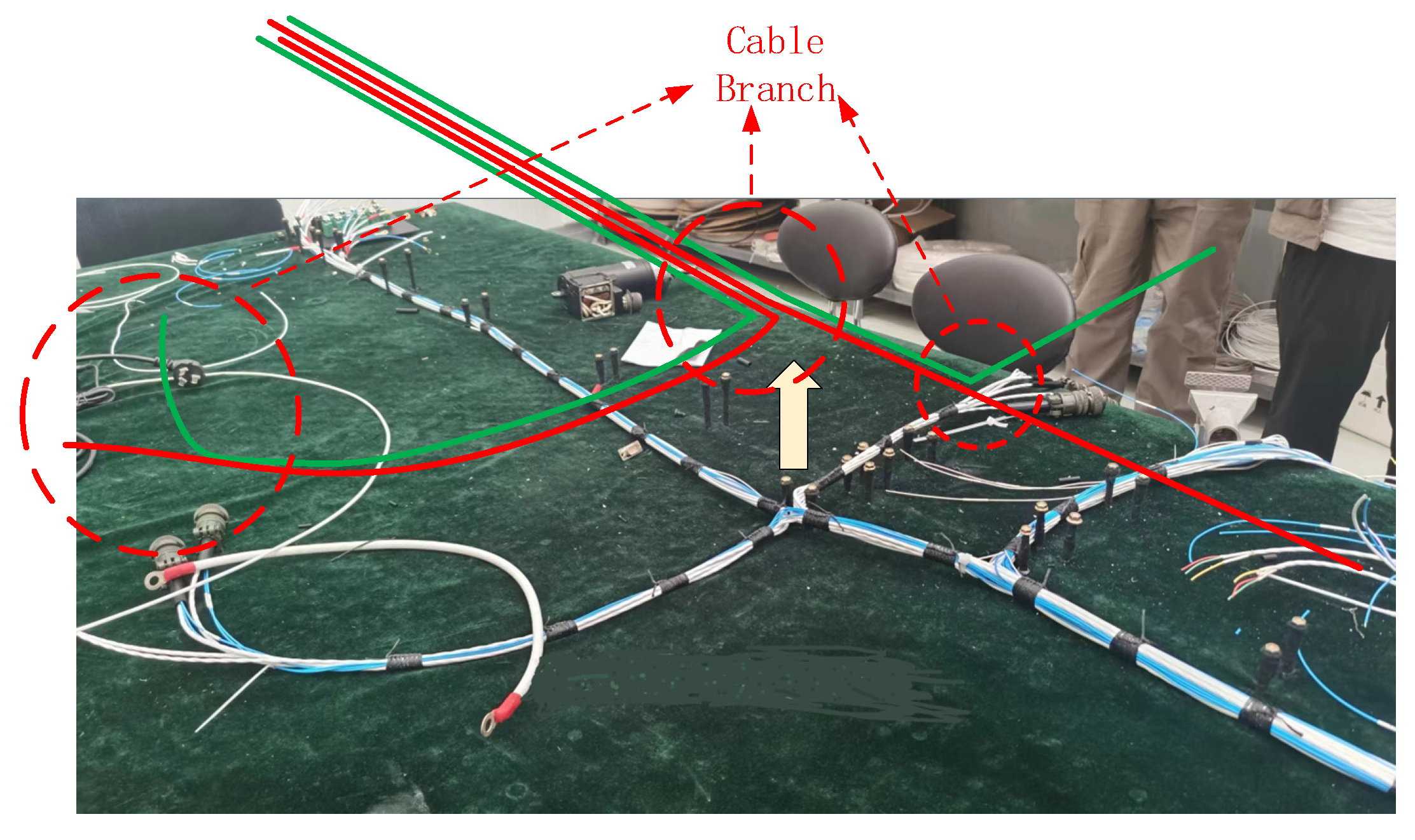

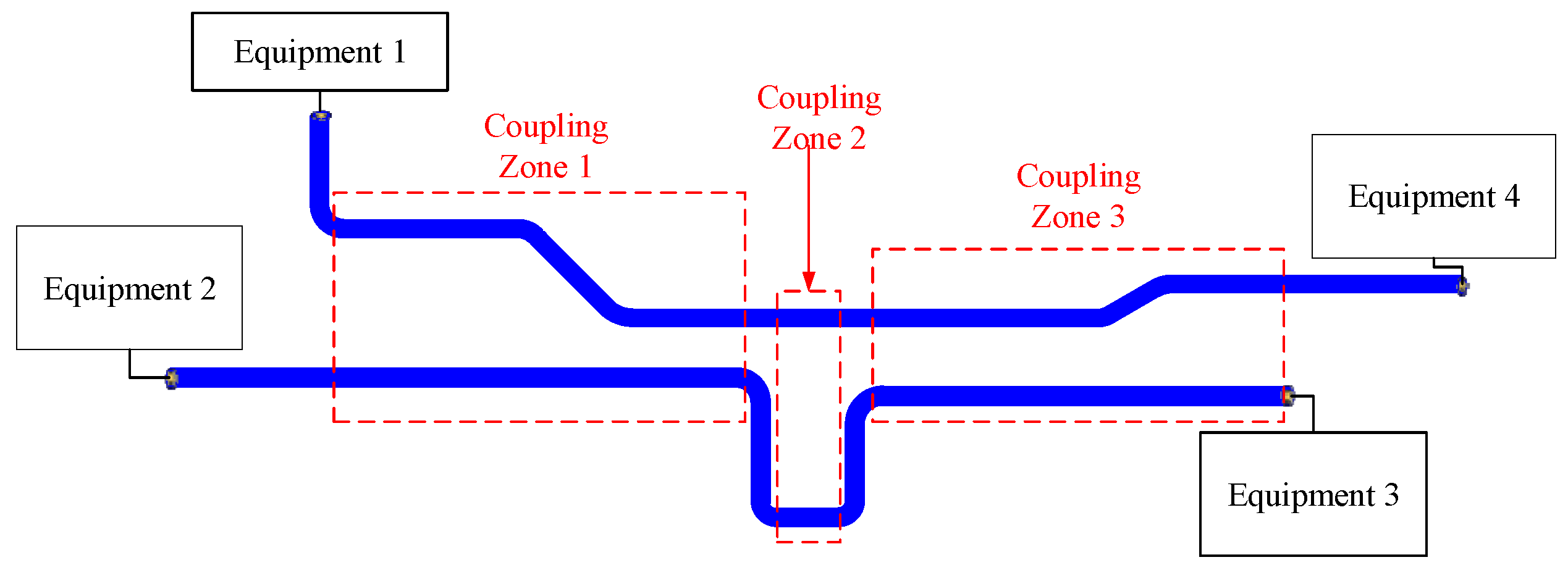
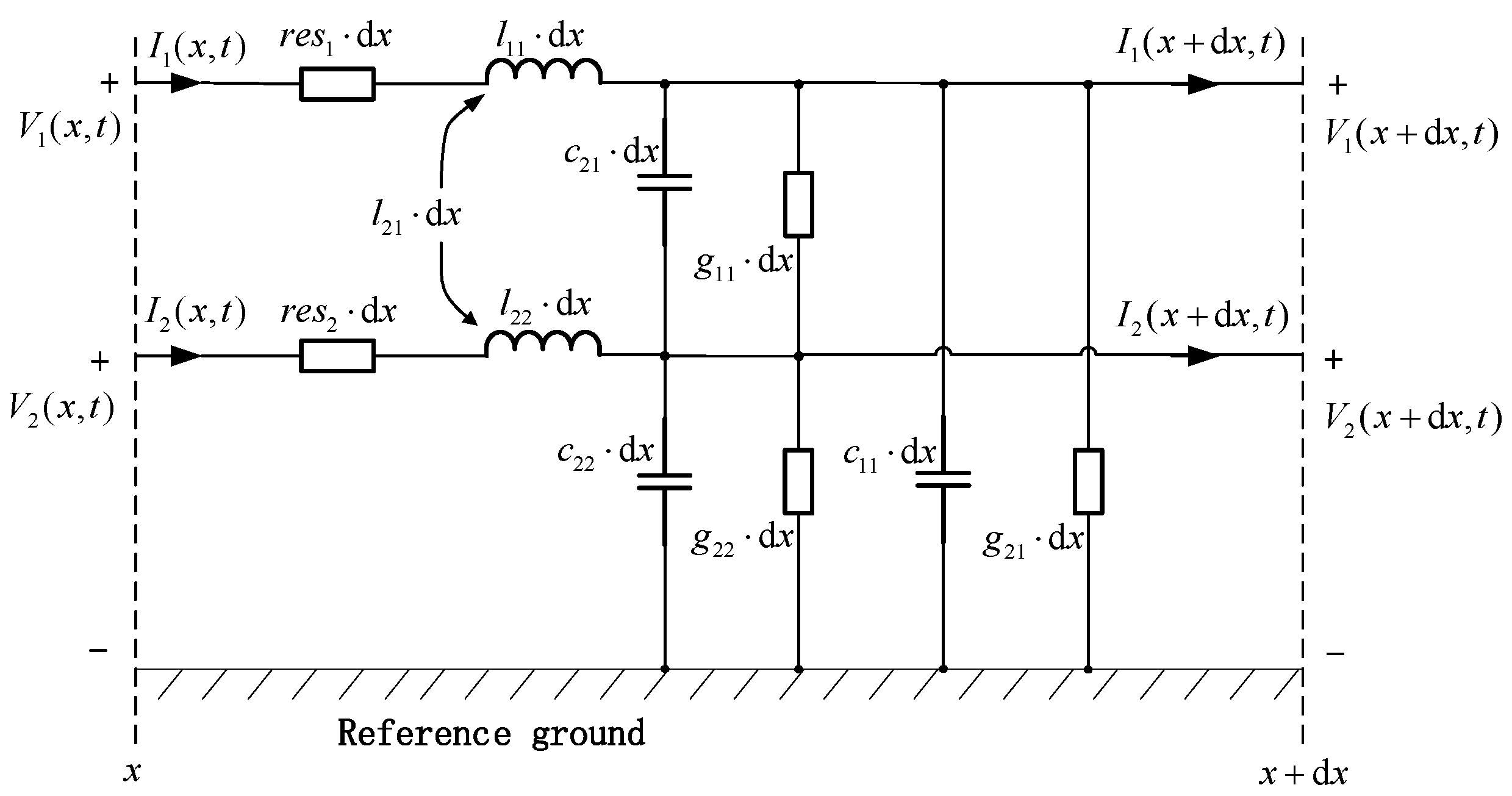
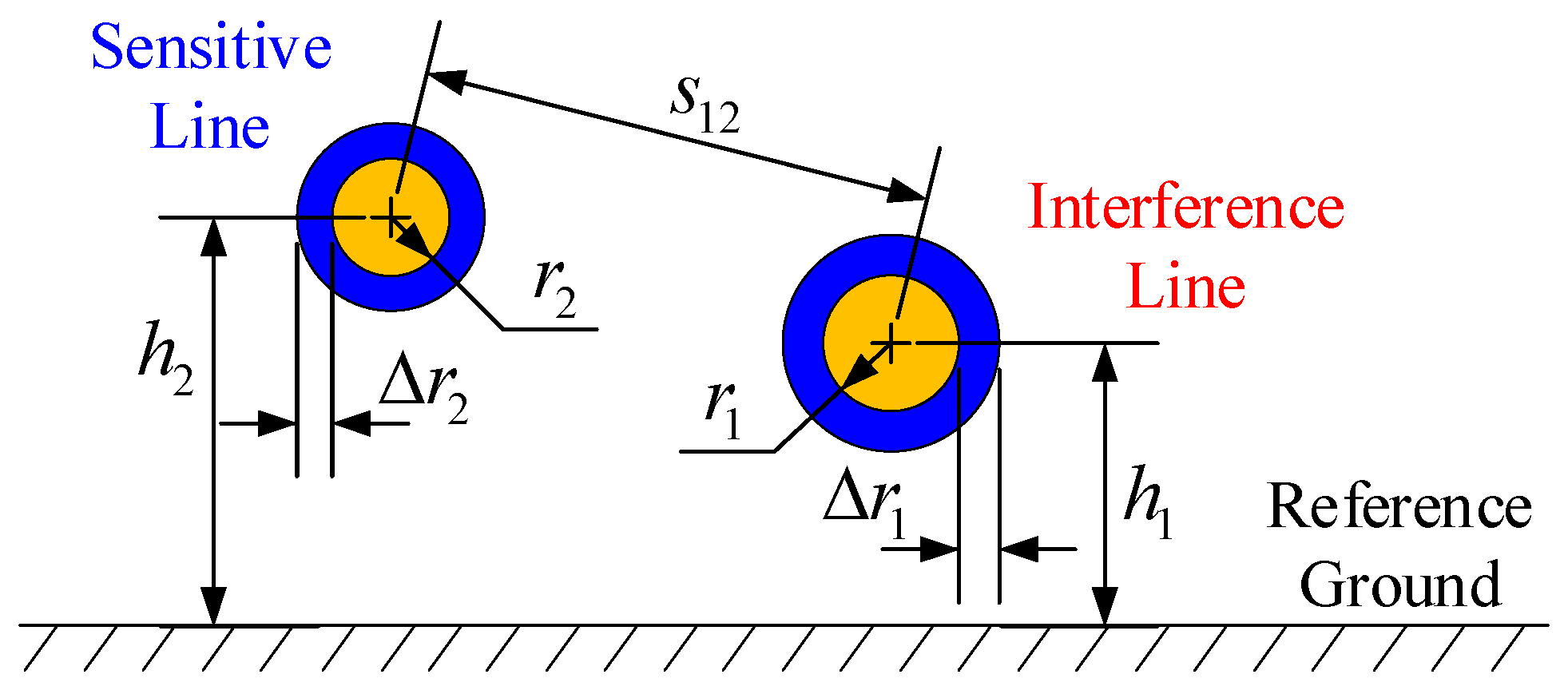


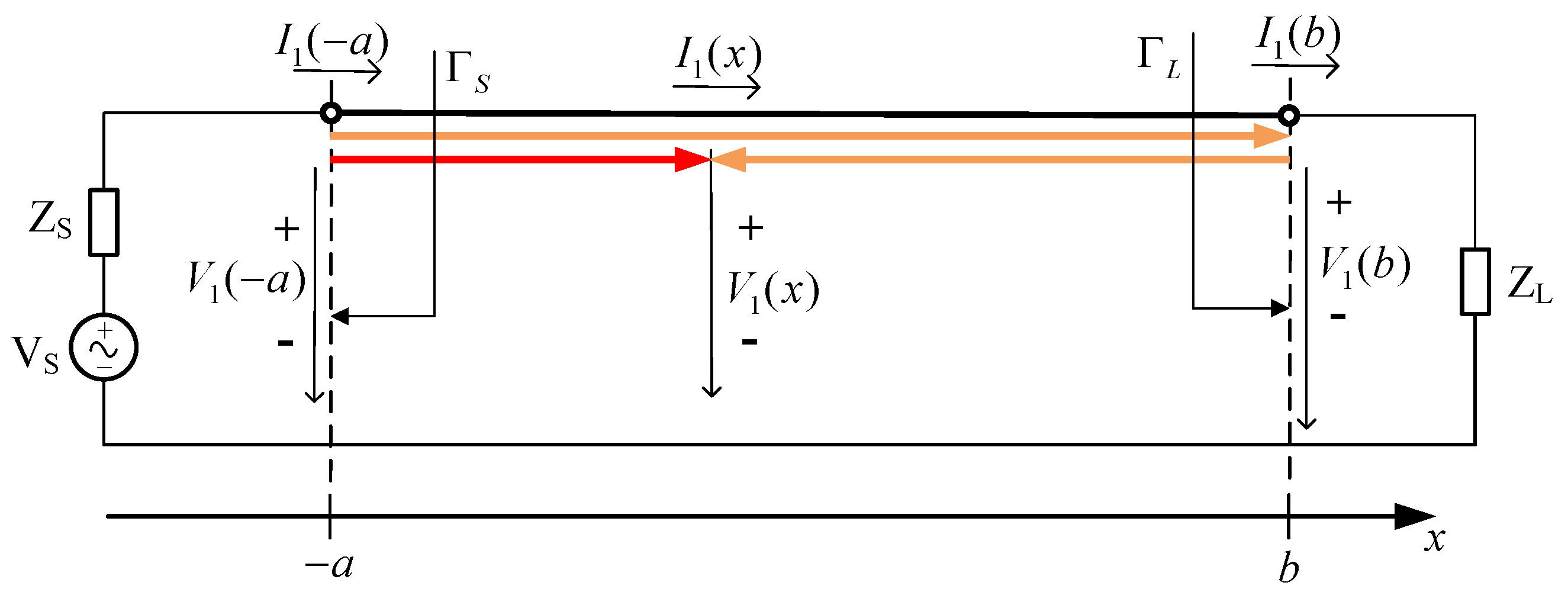

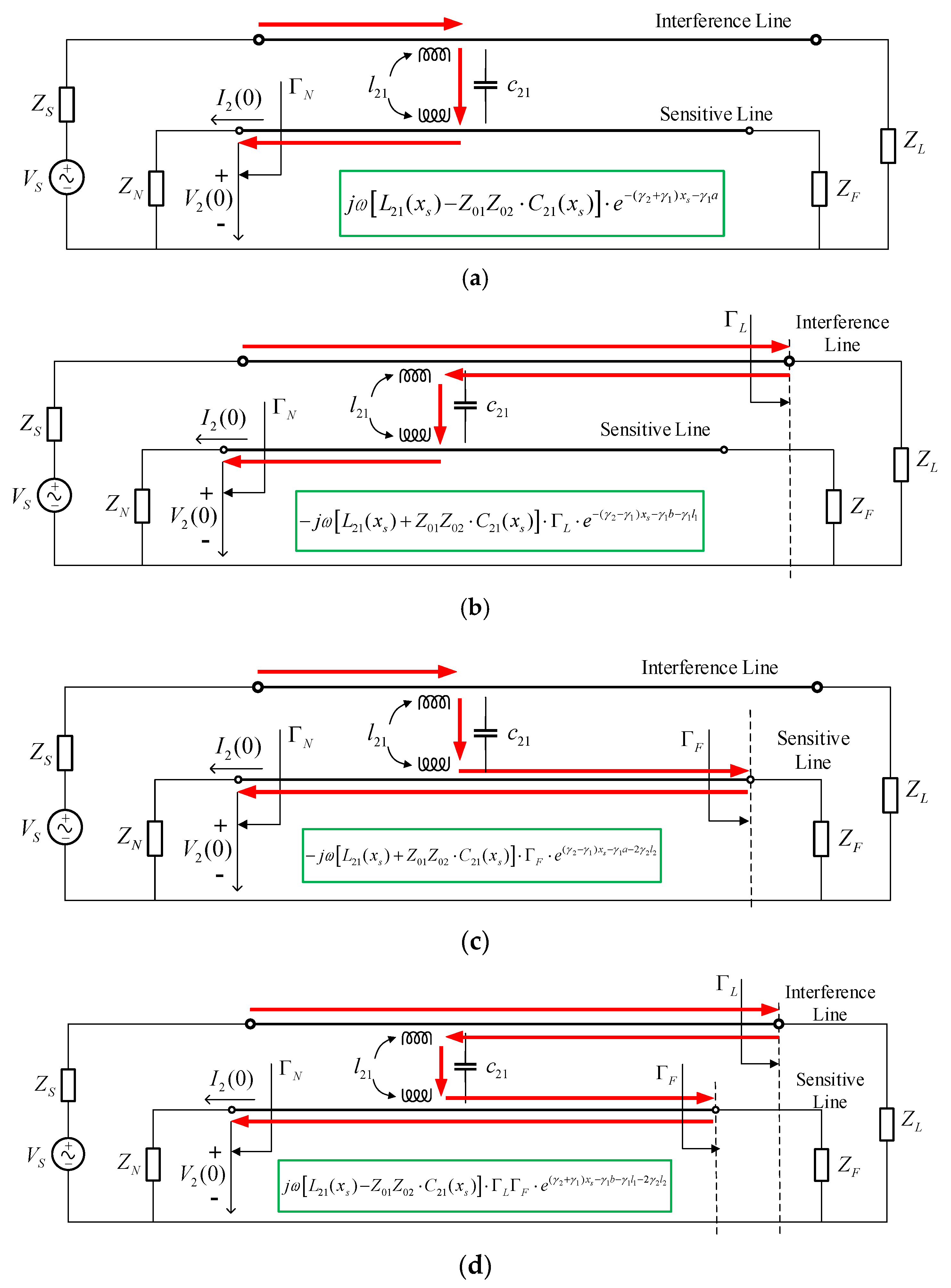

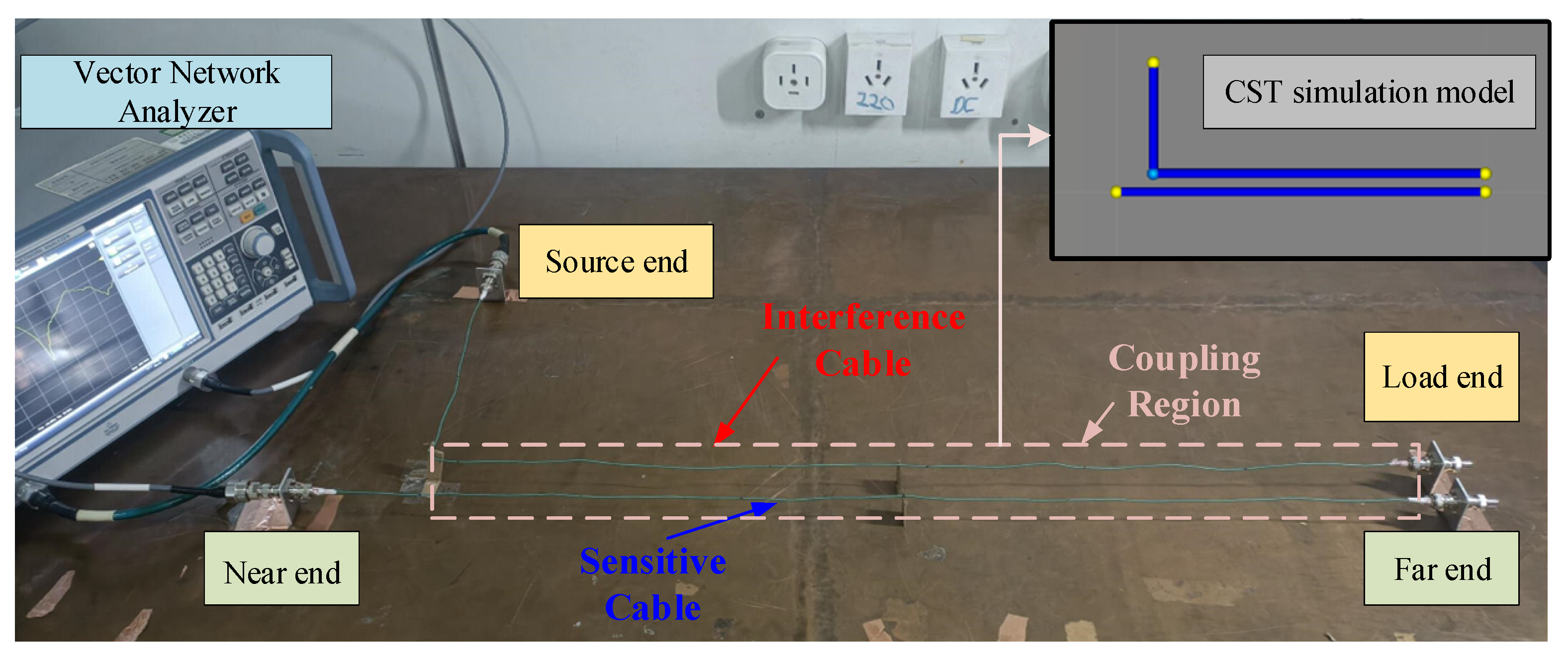
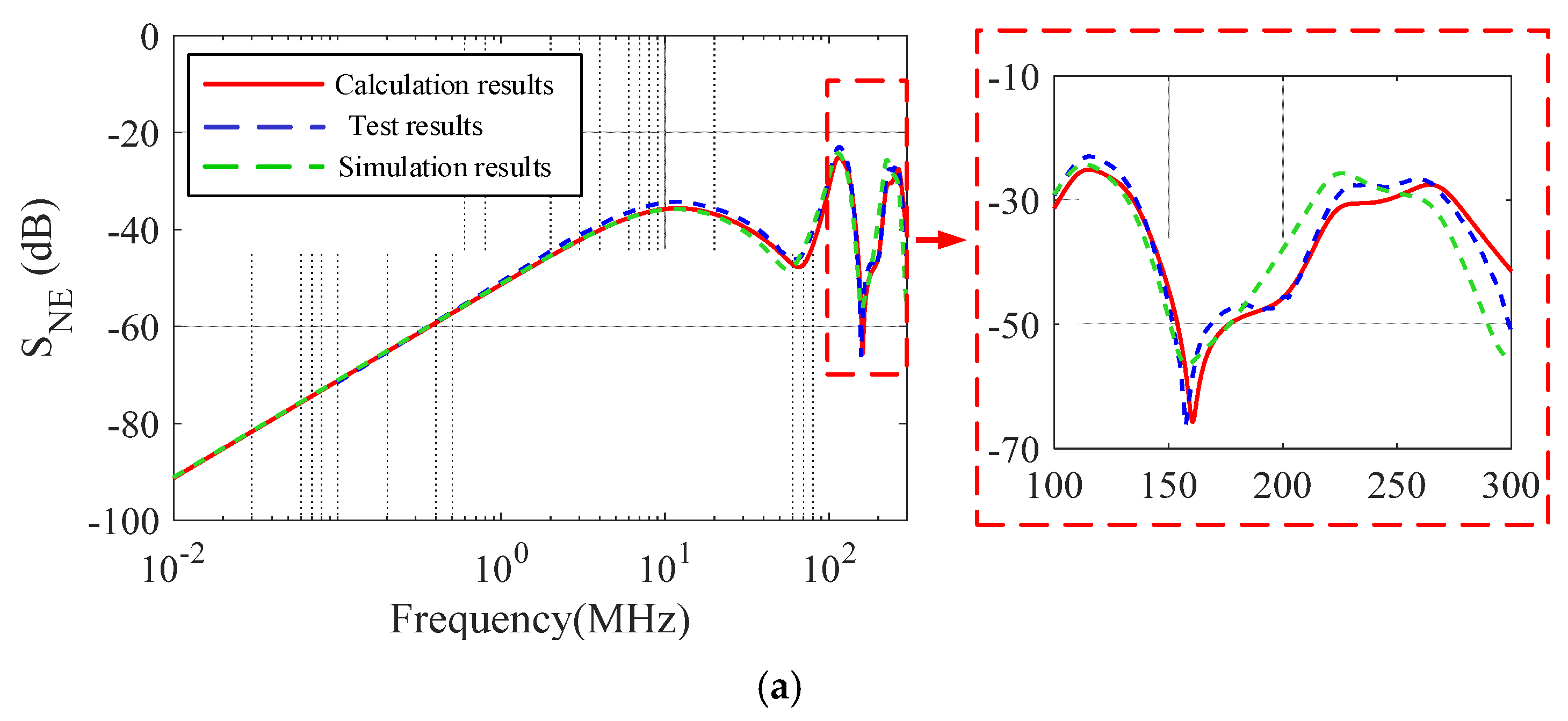
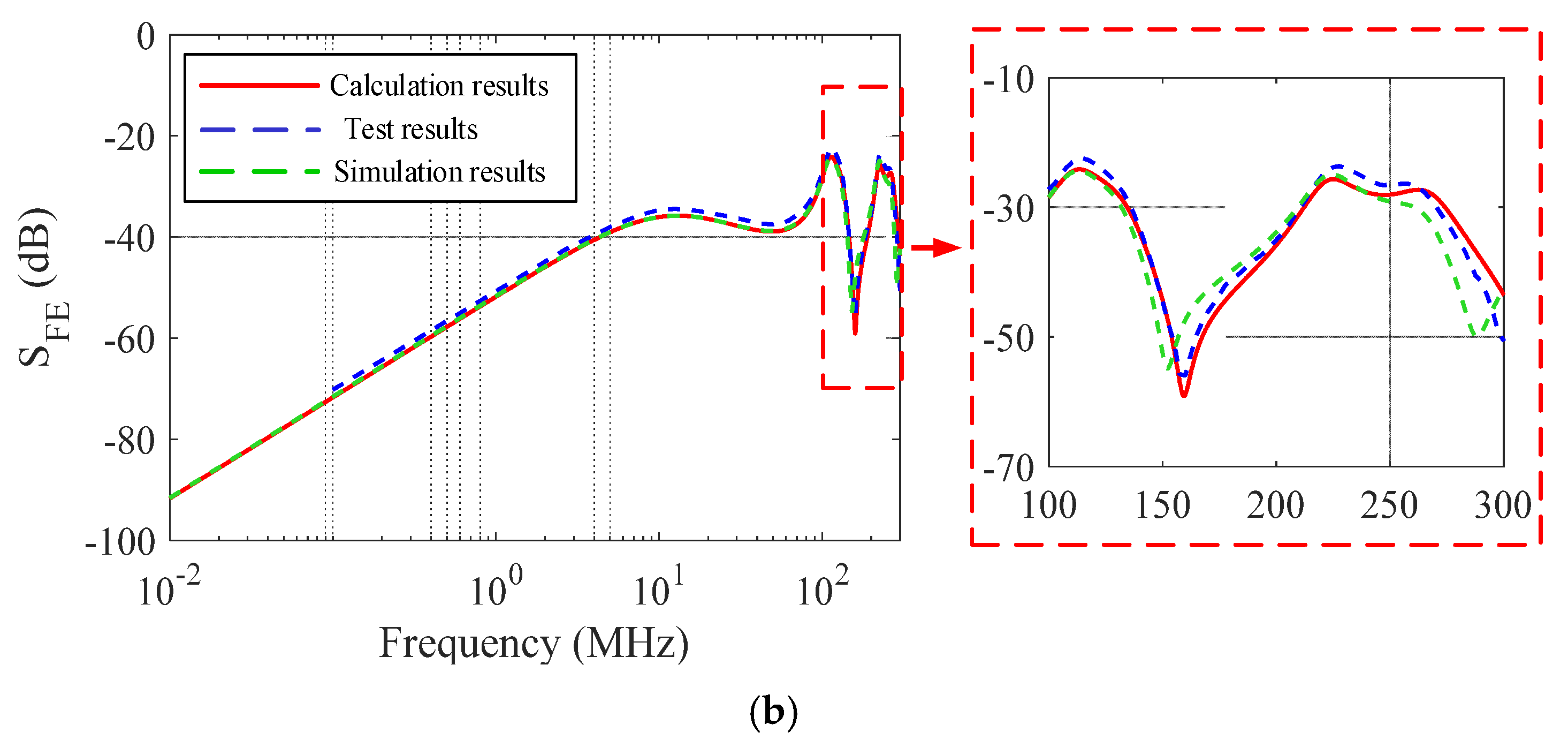

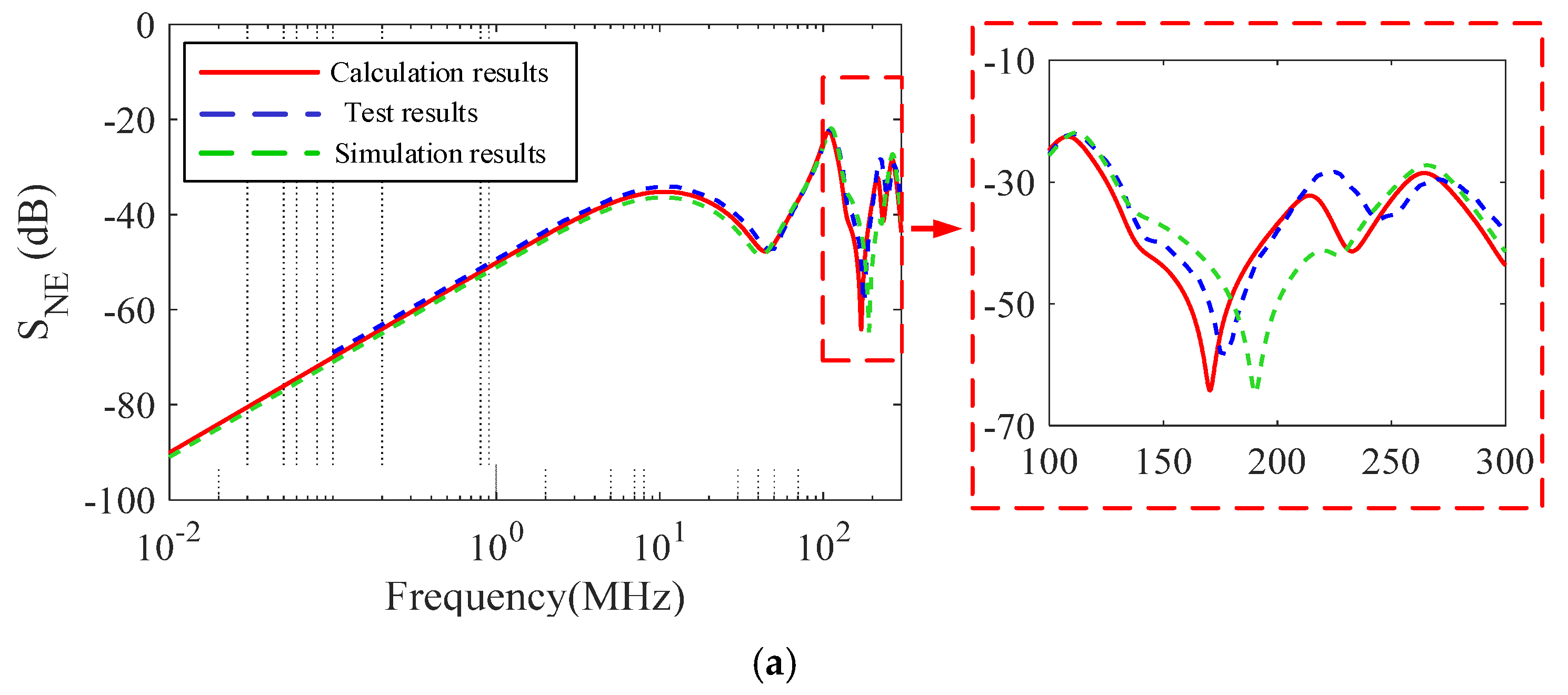

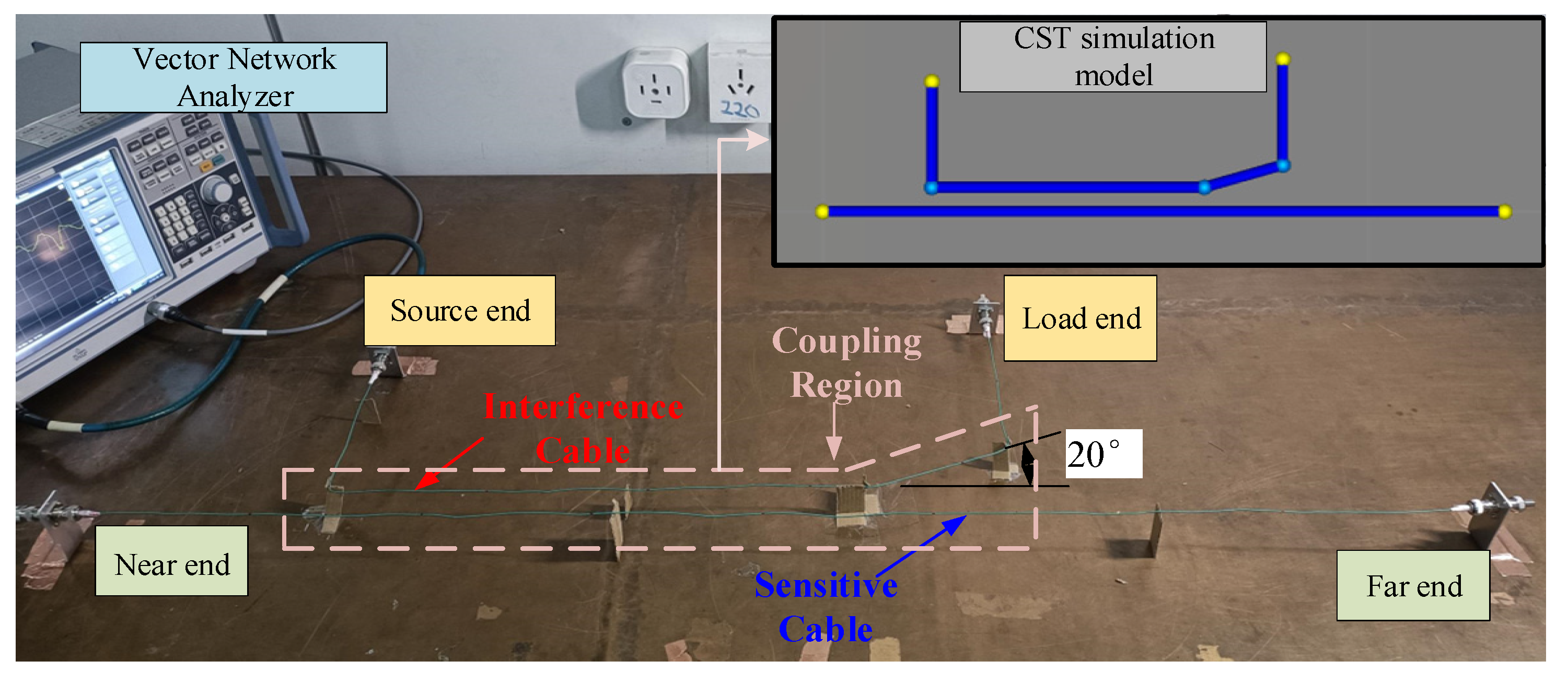
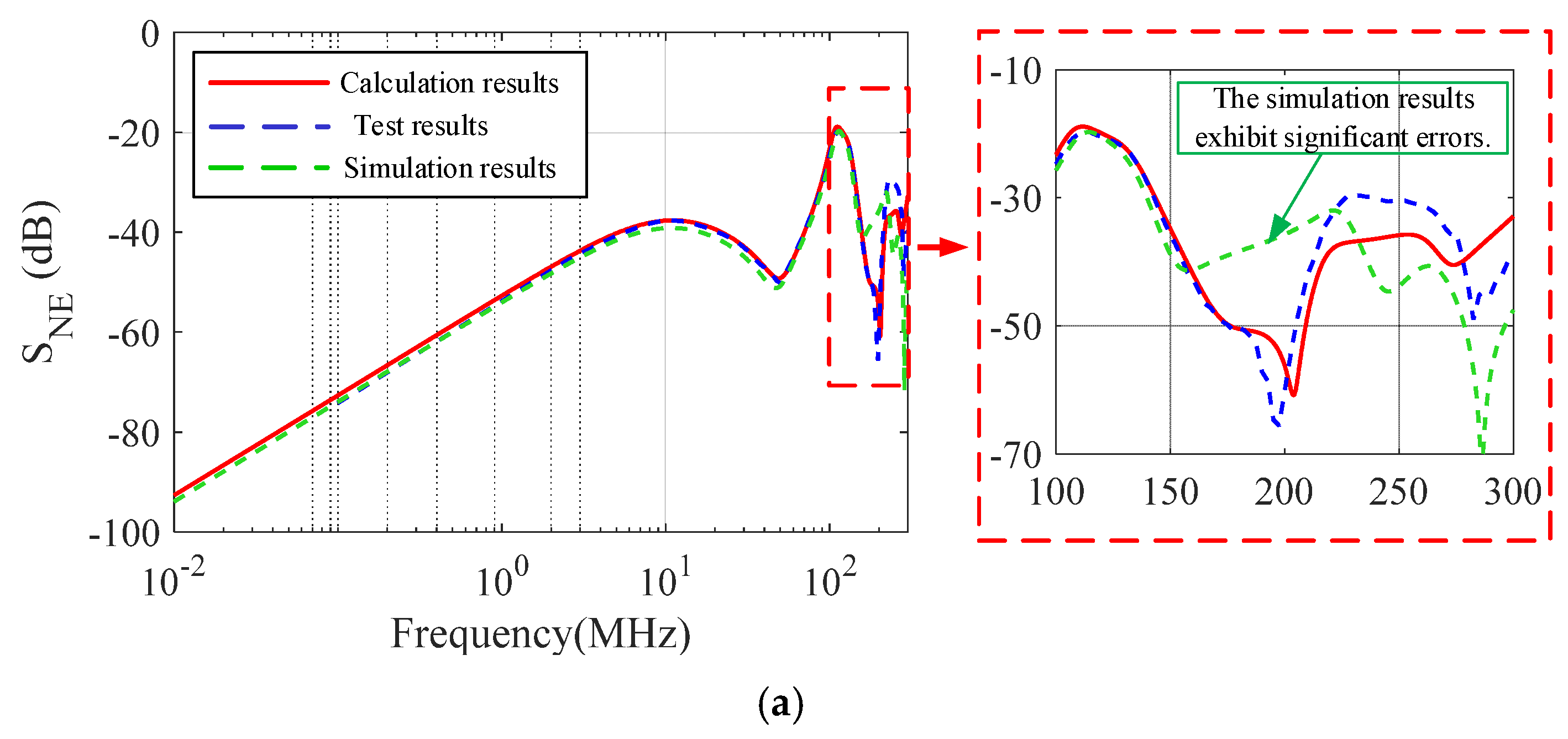

| Parameters | ||||||||||
|---|---|---|---|---|---|---|---|---|---|---|
| Scenario 1 | 1.2 m | 0.2 m | 30 mm | 1 m | 30 mm | 50 mm | 0.1 m | 1 m | — | — |
| Scenario 2 | 1 m | 0 | 30 mm | 1.2 m | 50 mm | 50 mm | 0 | 0.7 m | 1 m | 30° |
| Scenario 3 | 1 m | 0 | 30 mm | 1.2 m | 50 mm | 50 mm | 0.2 m | 0.7 m | 0.85 m | 20° |
Disclaimer/Publisher’s Note: The statements, opinions and data contained in all publications are solely those of the individual author(s) and contributor(s) and not of MDPI and/or the editor(s). MDPI and/or the editor(s) disclaim responsibility for any injury to people or property resulting from any ideas, methods, instructions or products referred to in the content. |
© 2025 by the authors. Licensee MDPI, Basel, Switzerland. This article is an open access article distributed under the terms and conditions of the Creative Commons Attribution (CC BY) license (https://creativecommons.org/licenses/by/4.0/).
Share and Cite
Ren, Y.; Tian, J.; Jia, Y.; Zuo, J.; Xie, X.; Liu, Y.; Xu, Z.; Zhang, P. Research on Crosstalk Calculation Methods of Installed Cables. Electronics 2025, 14, 4640. https://doi.org/10.3390/electronics14234640
Ren Y, Tian J, Jia Y, Zuo J, Xie X, Liu Y, Xu Z, Zhang P. Research on Crosstalk Calculation Methods of Installed Cables. Electronics. 2025; 14(23):4640. https://doi.org/10.3390/electronics14234640
Chicago/Turabian StyleRen, Yuxi, Jin Tian, Yaoxing Jia, Jingqi Zuo, Xianwen Xie, Yanhui Liu, Zihe Xu, and Peng Zhang. 2025. "Research on Crosstalk Calculation Methods of Installed Cables" Electronics 14, no. 23: 4640. https://doi.org/10.3390/electronics14234640
APA StyleRen, Y., Tian, J., Jia, Y., Zuo, J., Xie, X., Liu, Y., Xu, Z., & Zhang, P. (2025). Research on Crosstalk Calculation Methods of Installed Cables. Electronics, 14(23), 4640. https://doi.org/10.3390/electronics14234640





